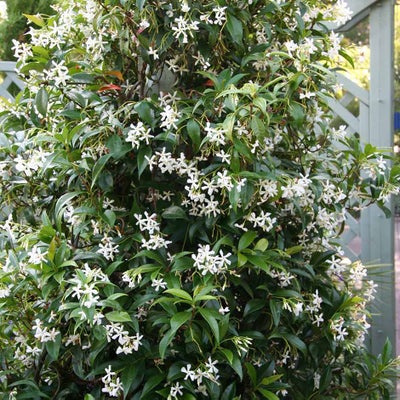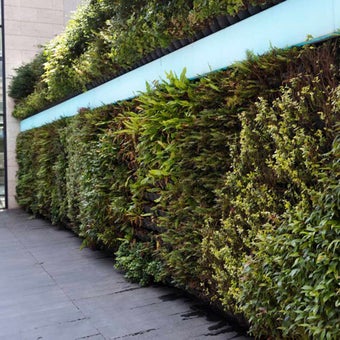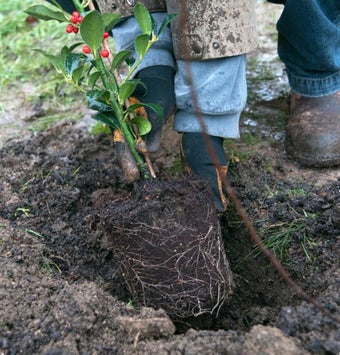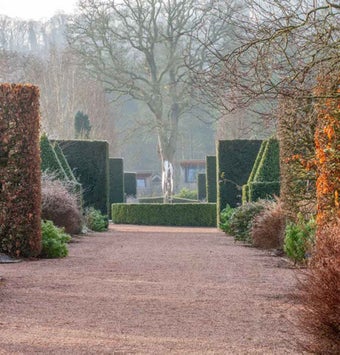
Quick facts
Our top 5 plants for screening:
Elaeagnus x ebbingei AGM
Magnolia grandiflora
Photinia × fraseri ‘Red Robin’ AGM
Quercus ilex
Sorbus vilmorinii AGM
Practical considerations
Before planning your screen, look at what soil type you have. This will affect your selection. Soils can be improved, but if it is clay, particularly sandy, or chalky, some shrubs will more suitable than others.
- Decide what ultimate height you need the screen to be and choose plants that will not outgrow the space or take too long to reach the required height
- Avoid being tempted to plant very large specimens. Establishment is best if you plant shrubs at no taller than 1m (3¼ft), or trees at 1.8m (6ft)
- If the area to plant is exposed, you may need to establish a shelterbelt or windbreak so that the screening plants benefit from the protection, especially as young specimens
- Ensure that the ground is prepared for planting. Plenty of organic matter dug into the planting area will give the plants a good start
- Consider your current (and future) ability to maintain any fast-growing evergreen hedges or screens
- The roots of trees can spread a considerable distance, so the proximity of drains, soakaways, structures or buildings needs to be borne in mind. This will avoid problems either on your property or your neighbour’s
Design considerations
Think about the effect and appearance of the plants you choose;
- Consider the size of the leaves in relation to the proposed size of the screen. Large-leaved plants such as laurel or Magnolia grandiflora are in scale with a tall screen. Small-leaved plants such as Pittosporum can grow quite tall, but if allowed to do so may not look in proportion
- You may wish to create a screen from living material such as willow. This gives an informal screen and can be woven into as complex or simple shape as your skill or taste allows
Legal considerations
There are several planning regulations that may affect the placement of a screen:
- Any new tree or hedge planting, adjacent to or nearby a public right of way or highway, may require the consent of the Highways and Byways department of your local council. Check that the covenants attached to your property do not prohibit the planting of specified species or features
- Check whether your property is in a Conservation Area. If so, you may have to apply for permission to carry out maintenance work to any screening you establish, although if the planting constitutes a hedge, permission may not be necessary
- If planting a line of two or more evergreens, your screen may fall under the definition of a high hedge
You will also need to plant responsibly when planning a screen near to buildings
Suitable plants
Suitable plants for screening can include hedging shrubs, trees or grasses and bamboos, depending on the level of formality, and the height and spread required for the space.
Hedges
A useful way of using large shrubs as tree substitutes is to clear the lower branches as they grow so that the space underneath is maximised and plants below receive adequate light. This is especially effective as a means of continuing screening above a 1.8m (6ft) standard boundary fences. The canopy then branches out above the fence.
Evergreens
Arbutus unedo AGM: to Ireland . This has white flowers from October-November and red fruits. Height 8m (24ft).
Eucalyptus gunnii AGM: The adult leaves are long and grey-green and juvenile leaves rounded and mid-green or grey-green. Height 10m (30ft) to 25m (80ft).
Ilex aquifoliumAGM: Native to GB and Ireland
Ilex aquifolium 'Madame Briot' AGM: of Native to GB and Ireland
Ligustrum japonicum: This shrub has dark green glossy leaves which are upright and dense. White flowers from mid-summer to early autumn. Height and spread 3m (10ft) by 2.4m (8ft).
L. lucidum AGM: has bright green leaves. White flowers up to 20cm long (8in) in late summer to early autumn. Height and spread both 10m (30ft).
Magnolia grandiflora: has leathery, glossy green leaves with felty brown undersides. Large, white, scented flowers are produced from late summer to autumn. Height and spread 6-18m (20-60ft) by 15m (50ft).
Olea europaea: is a slow growing evergreen tree with grey-green leaves, reaching a height and spread both 10m (30ft).
Photinia × fraseri 'Red Robin' AGM: is a compact form of Photinia with bright red young leaves. White flowers are produced from mid- to late spring. Height and spread 5m (16ft) by 5m (16ft).
Prunus laurocerasus 'Rotundifolia': is vigorous and makes excellent screening, becoming tree-like after some years. It bears fragrant white flowers from mid- and late spring 5m (14ft) by 4m (13ft).
Quercus ilex AGM: is a rounded tree with smooth . It responds well to being pruned. Height and spread 25m (80ft) x 20m (70ft).
Taxus baccata AGM: Native to GB and Ireland
Trachelospermum jasminoides AGM: is a vigorous, twining climber with glossy dark green leaves that turn bronze-red during winter. Fragrant pure white flowers are produced from mid- to late summer. Height and spread 4-8m (12-25ft).
Grasses and bamboo
Grasses and bamboos, if chosen carefully can provide an attractive screen that, in a breeze, adds movement and sound to the garden.
Miscanthus sinensis cultivars such as the 2m (6½ft) tall M. sinensis ‘Silberspinne’ and the 1.5m (5ft ) M. sinensis ‘Morning Light’ make an informal screen for summer.
Bamboo screening
Take care to choose species that will form clumps and not become .
Chusquea montana: is clump forming and has a tidy compact upright habit. Height 1-3m (3-10ft): average height 2m (6½ft) at Wisley. It spreads 75cm-1.5m (30in-5ft) in 10 years.
Fargesia murieliae AGM: is a clump-forming bamboo with small leaves reaching a height and spread of 4m (13ft) by 2.5m (8ft).
Fargesia nitida: is similar, but may not grow quite as tall (2-4m (6½ft-13ft)) as F. murieliae.
Small trees
Small trees that are suitable for the smaller garden, perhaps to intercept the view of a neighbour’s extension include:
Crataegus monogyna:Native to GB and Ireland
Crataegus persimilis 'Prunifolia' AGM: has crimson fruits and good foliage colour. Height: 8m (26ft).
Malus 'Evereste' AGM: has white flowers in late April, followed by yellow fruits. Height 7m (22ft) by 6m (20ft).
M. × robusta 'Red Sentinel' AGM: has long-lasting red fruit 2.5cm (1in) across. Height 7m (23ft)
Prunus 'Umineko': is a narrow-growing, upright tree with white flowers in spring. Height 8m (26ft).
Pyrus salicifolia 'Pendula' AGM: has silvery-grey foliage and a weeping habit. Height 5m (16ft).
Sorbus aucuparia 'Sheerwater Seedling' AGM: Cultivar of Native to GB and Ireland is a vigorous, upright small tree with compact ascending branches with red-orange berries and autumn colour. Height 10m (33ft).
S. vilmorinii AGM: has rose-red to white fruits and good autumn foliage colour. Height 5m (16.5ft)
Exposed coastal situations
The choice is more limited by the coast, but the attractive low-branched, spreading Pinus radiata (Monterey pine) will thrive as will Quercus ilex (holm oak) but this may be rather slow growing early in its life. However, it can be hard pruned and even topiarised in later years.
For large-scale screening
Where space is not a problem a mixed screen of some depth can be planted. For example, silver birches (Betula Pendula): native to GB and Ireland, and Scots pine (Pinus sylvestris) native to GB, interplanted in two rows 4.5m (15ft) apart can be very effective especially when underplanted with cotoneasters, viburnums and poplars which can be removed as the screen develops. A more formal approach might include Catalpa bignonioides 'Aurea', Davidia involucrata,Fagus sylvatica ‘Dawyck’ AGM: cultivar of Native to GB and Ireland, Quercus rubra, Prunus padus: native to GB and Ireland,orSorbus aria 'Lutescens': Cultivar of native to GB and Ireland.
Shady sites on poor soils
Shady sites can be challenging, but consider the evergreens Prunus laurocerasus, Ilex aquifolium: native to GB and Ireland or Taxus baccata: native to GB and Ireland. These can be planted as a dense hedge or as an extensive screen that will tolerate hard pruning. Where there is more sun, consider Elaeagnus × ebbingei or E. pungensfor screens up to 4m (13ft). These also tolerate hard pruning.






